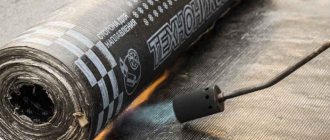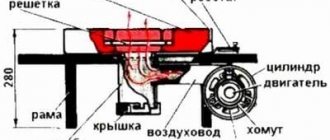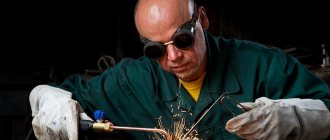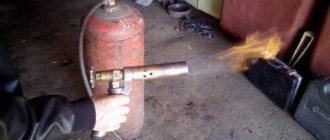What to make a workbench from
I decided to make a workbench from 40x40 and 20x40 profile pipes. Wall thickness 2 mm. Most expensive workbenches that can be found on sale are made from a profile with a wall thickness of 1.5 mm. But we do it for ourselves, so we won’t be greedy. If corrosion begins to corrode the metal profile, it will not cope so quickly with a thicker wall.
We will make 3 rectangular supports from a 40x40 pipe. The lintels inside the supports, guides, and crossbars under the table top are made from 20x40 pipe.
In addition to the profile itself, we will need:
- board for the countertop (I have OSB);
- alkyd enamel for metal “three-in-one”;
- welding accessories;
- Bulgarian;
- corner and core for marking metal profiles;
- other little things.
Instructions for making a pipe bender
Making a pipe bender for a profile pipe yourself is not at all difficult if you adhere to the following technological sequence.
- Gears, bearings and rings are placed on the pressure shaft, which are connected to it using a key. First, a drawing of such a shaft, races for bearings and rollers is developed, then these parts are turned, which is best entrusted to a qualified turner. In total, for this device it is necessary to make three shafts, one of which is suspended on springs, and the other two are located on the sides.
- Then it is necessary to drill holes in the rings, which are necessary for making grooves and threading.
- Now you need to make a shelf, for which you use a channel, in which you also drill holes and cut the threads required when installing the pressure shaft.
- After completing the preparatory measures, the entire structure of the equipment must be assembled, for which welding and bolted connections are used. First of all, the frame is installed, which also serves as the legs of the pipe bender.
- The next step is to hang the shelf with the pressure shaft attached to it, for which springs are used. After this, you need to install side support shafts on the homemade pipe bender, on one of which a handle is attached.
- The final touch is to install the jack on the pipe bender.
Some subtleties of installation work:
- the pressure shaft, fixed with keys, is additionally screwed to the shelf;
- installation of the pressure shaft is carried out according to the following scheme: the shaft is installed on a shelf to which nuts for the springs are pre-welded; after the installation work is completed, the shelf is turned over and suspended on the springs;
- the chains are tensioned using a magnetic corner, which is used as a holder;
- when tightening the sprockets, keys are used, which are pre-made from Grover;
- the drive handle for the bending machine is made with a rotating tube;
- The jack on such a homemade device is installed on a suspended platform, for which bolted connections and welding are used.
Sawing a profile for a workbench
To make a workbench from a profile, we will need to cut it into pieces. These drawings not only show the design of the future workbench, but also indicate the dimensions of all the sections into which the pipe will need to be cut, and its total footage.
An important point: we will make cuts strictly at an angle of 45°. This is necessary in order to weld all the parts without gaps. If moisture gets inside the structure, corrosion will begin to corrode the metal.
To mark the profile, we use a core (a tool for making marks on metal) and a corner. It is better to mark the pipe along all four edges so that the cuts are even. How I mark the profile and cut it with a grinder can be clearly seen in the video.
Device
Such home-made products in the countryside, such as a mini-tractor, are distinguished by a rather simple design structure, which provides certain advantages to the person who will carry out the assembly process. For a skilled owner, it will not be difficult to assemble a homemade tractor with your own hands at home.
Frame design
Due to the fact that homemade units are made in the image and likeness of their store-bought “brothers,” their design will be largely similar.
Conventionally, you can divide a homemade mini tractor into several working units:
- Frame design. This is perhaps the most important part of the mini tractor design, because the stability and performance of the entire unit will depend on the strength of the frame.
- Transmission. This device can be taken from old Soviet cars, which are quite suitable for these purposes.
- Gearbox.
- Wheelbase. For this purpose, you can use wheels from old equipment - the same domestic cars.
- Power unit. In a homemade mini tractor, you can use a walk-behind tractor as the main driving force. Consequently, the same engine will be used as on the walk-behind tractor, but this is not a strict recommendation (see how to make a tractor from a walk-behind tractor with your own hands).
- For these purposes, you can use another engine, preferably running on a diesel engine, with decent power (at least 9 hp).
- Steering.
- Other components. This includes the clutch, driver's seat, etc.
As we can see, most of the components will be borrowed from old, out-of-date equipment, so manufacturing costs are minimal. The only thing is that you will have to work a little with welding the frame and setting up the controls, but for a rural craftsman this is a common thing and does not cause any special problems.
DIY painting
Now a little about the best way to paint a metal profile.
I bought an inexpensive Dali three-in-one alkyd enamel for this. This is paint, primer and rust converter - all together. Its beauty is that you can degrease the surface and immediately apply paint. With rust, if it is insignificant, you do not need to do anything. The paint will do the job. If there is too much rust, it must first be cleaned and treated with a converter. Otherwise the paint will swell, and then it will peel off.
If you want a workbench in the same beautiful rich blue color as mine, choose a shade according to RAL 5005. Be sure to paint it in two layers.
Characteristics and types of injection burners
The design of the forge burner determines the degree of waste of the metal when it is heated for forging, the intensity of scale formation on the surface, and the total gas consumption. In closed forges, short-flame burners are used.
Their design guarantees rapid mixing of the combustible mixture, which ensures high efficiency. Combustion products are removed from the furnace working space evenly and as efficiently as possible.
Operating principle of burners
In burners of this type, propane coming from a gas pipeline or cylinder is burned. Here, a mixture of gas and air is formed due to ejection, i.e. the latter being sucked into the burner under the influence of the energy of a gas jet under pressure.
In the area where air is taken in, a vacuum appears, due to which the air itself moves in a given direction. Mixing in the burner body, the working mixture escapes from it under pressure, creating the desired temperature.
The quality of operation of a gas burner depends on the constancy of the ratio of the volume of gas and air. Changes in gas density affect the burner's ability to suck in air.
The fuel combustion device or burner is the main component of the gas furnace. Its operation depends entirely on the correct manufacture of this key element
All changes in combustion temperature must be accompanied by similar changes in the air supply required for combustion.
If the indicators are unbalanced, the injection coefficient must be adjusted to achieve its stability. This is achieved by changing the gas pressure or adjusting the air damper.
Classification of burners according to main characteristics
They are classified according to different criteria. Based on the volume of primary air sucked in, a distinction is made between partial-mix and full-mix burners. The main characteristics of the former are the injection coefficient and the multiplicity.
The injection coefficient is determined by the ratio of the volumes of air injected and those required for 100 percent combustion of gas. The expression “injection ratio” refers to the relationship between the volume of primary air and the gas consumption of the burner.
Combustion of gas mixed with air in an injection burner occurs in a special nozzle - a tunnel made of refractory material
Injection burners used in home forges come in low (up to 5 kPa) gas pressure and medium - from 5 kPa to 0.3 MPa. When the gas in the burner is under a pressure of 20-90 kPa, the power of air suction remains practically unchanged, even when the gas pressure and vacuum in the furnace undergo changes.
When the pressure drops below this level, the injection coefficient increases, the pressure drops, and the vacuum in the forge increases. Depending on the presence of the distribution manifold, there are single- and multi-flame burners.
There is a division according to the number of nozzles: with one nozzle - single-nozzle, with several - multi-nozzle. These elements are placed in the center or scattered. According to this feature, there are burners with a central nozzle and a peripheral one.
Estimate
As I already said, the cost of this metal profile workbench along with paint is 3,500 rubles. You can make it even cheaper if:
- use a 30x30 profile;
- take a pipe with a wall thickness of 1.5, not 2 mm, like mine;
- make the workbench shorter (not everyone needs such a huge one).
In the future, I plan to complement this workbench with a wall-mounted tool frame and a roll-out cart. We will do all this together: watch the video on YouTube and the articles on my blog.
Video
Reviews
Adding comments to unauthorized users is prohibited. Log in or register on the site
Pros and cons of an injection burner
Using a high-quality gas burner for a forge has a number of advantages:
- use of gas energy for air injection;
- good mixing of air and gas;
- the ability to control the gas/air volume ratio when changing the burner temperature;
- ease of use;
- efficiency;
- simplicity of design.
With its advantages, there are also some disadvantages. Single-nozzle burners, taking into account the heat output, are quite long. It is necessary to ensure strict alignment of the axis of the nozzle and the burner. They make a lot of noise during operation.
The power of an injection burner is determined by the volume of gas it consumes per unit of time. This parameter differs significantly for different burners
Significant disadvantages of low-pressure burners are the long flame length, as well as the dependence of the secondary air supply rate on combustion liquefaction.
The following article will introduce you to the types of gas burners for sauna stoves and methods of their installation, which should be read by all owners of suburban areas with their own saunas.
Cutting external and internal threads on wood
In order to apply carvings to wood, tools such as a tap (cutter) and a die are used. They are used to apply both internal and external threads. But in order to carry out such work you need:
- take into account the density of wood, since not everyone is suitable for such procedures;
- internal thread requires pre-drilling a hole, the diameter of which should be less than the diameter of the tap;
- after that the hole is cleared of chips;
- For more successful work, you should use oil, for example, linseed, just drop a little of it into the hole, and then insert the tap.
The angle at which the tap is inserted must be straight; under no circumstances should distortions be allowed, otherwise the part will be damaged.
As for external threads, they are applied in approximately the same way:
- the diameter of the workpiece must be equal to the diameter of the die;
- after that oil is applied.
In addition to the die, you can also use a regular nut:
- the oiled workpiece is placed in a vice;
- then slowly screw in the nut using a wrench.
After the required number of grooves have been cut, unscrew it just as carefully.
Basic recommendations
First you need to navigate the choice of a suitable modification of the unit. It must have the necessary resource reserve to provide the required traction for cultivating the soil using attachments - hiller, plow, etc.
To find out what is required to create a full-fledged mini-tractor, you must first consider its basic components.
- Chassis. Made from available rolled metal.
- Rotating device.
- Simple disc brakes.
- Seat and body parts.
- A coupling device for mounting attachments, a system of levers for controlling it.
A considerable part of the parts can be purchased at scrap metal acceptance points or at auto scrap yards. In this case, you need to look at the quality and absence of damage.
Which thermal washer is better?
In their advice on how to better attach polycarbonate, many experts give preference to a thermal washer with a leg, which provides a stronger seal and reduces the risk of “leaks.”
In fact, the polycarbonate product itself and the fasteners for it are produced by different companies, so millimeter differences in the thickness of the plastic and sheet are quite possible, and therefore leaks in the fastening areas.
But polycarbonate sheets shrink at low temperatures, therefore, using universal thermal washers for them, it is better to “squeeze” the fasteners.
Thermal washers design
Fasteners for polycarbonate are classified into types:
- with a leg for a product of a certain thickness;
- universal without legs.
Structurally, the fastening of cellular polycarbonate includes:
- washer with or without a leg;
- seal (polymer ring);
- cover (copper or PVC washer);
- self-tapping screw
The use of dowels in the construction of houses and baths
Wooden dowels are used in the construction of various structures with log or timber walls. Their use is approved by the standards of construction organizations and projects of wooden houses. In practice, the use of birch tenons provides a perfect connection to wooden substrates. It is distinguished by the mobility of the vertical level. However, this does not prevent the wood from naturally shrinking.
In the process of building wooden houses, they often resort to making dowels for timber with their own hands.
Round birch nails give the building strength and security.
The build quality and reliability of the walls will be at the highest level and will please anyone.
What is an impact screwdriver
There are practically no visual similarities between an impact screwdriver and a standard one. This tool is a rotating impact mechanism that allows you to convert impact force into torque. It is used to install and dismantle threaded connections that require additional effort. Using a regular screwdriver for these purposes will lead to breakage of the tool or damage to the element being dismantled.
According to its operating principle, an impact screwdriver is similar to a bolt. During the work, the mechanic has to hold the handle of the screwdriver with one hand, while with the other he hits its end with a hammer.











